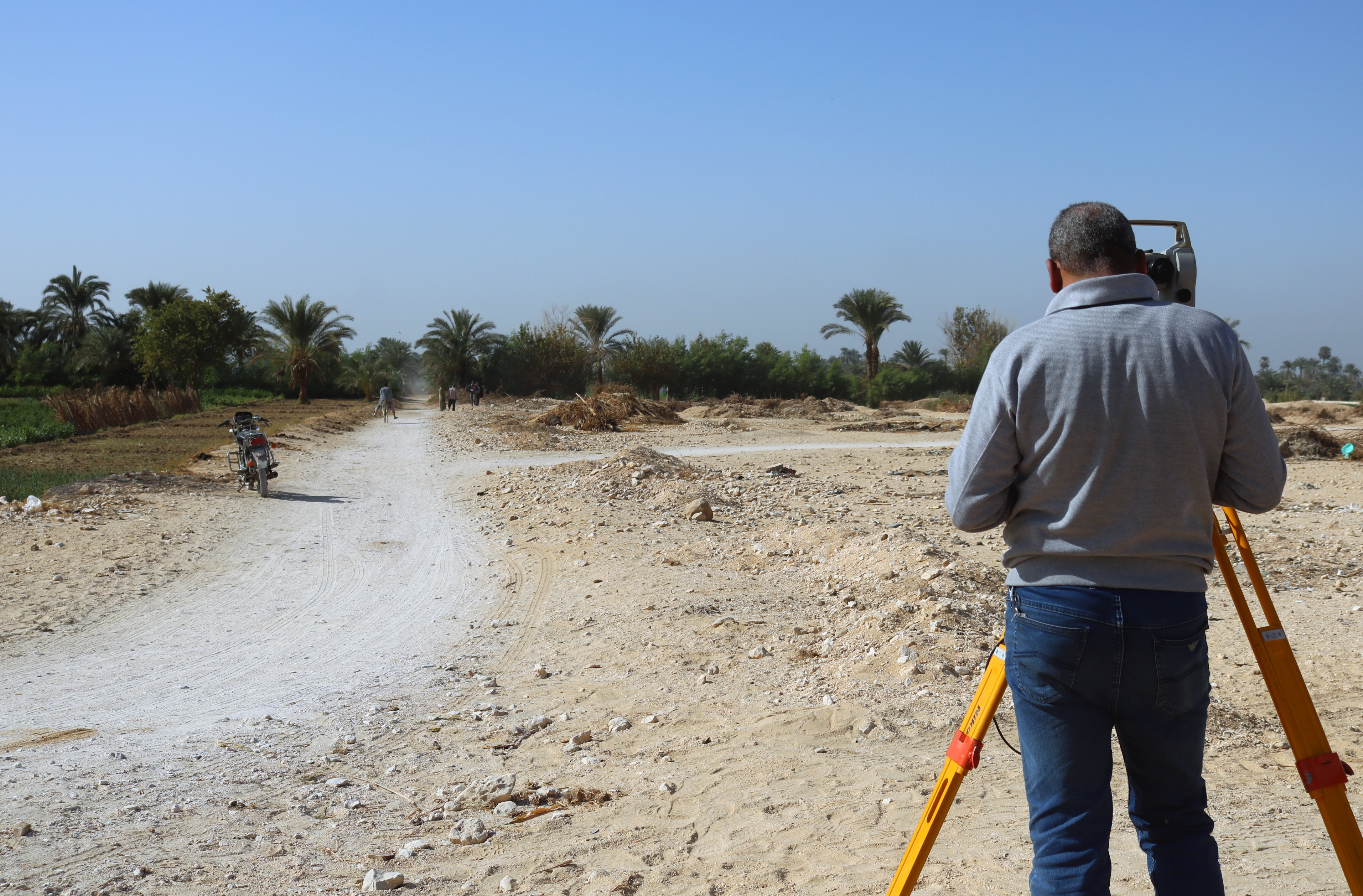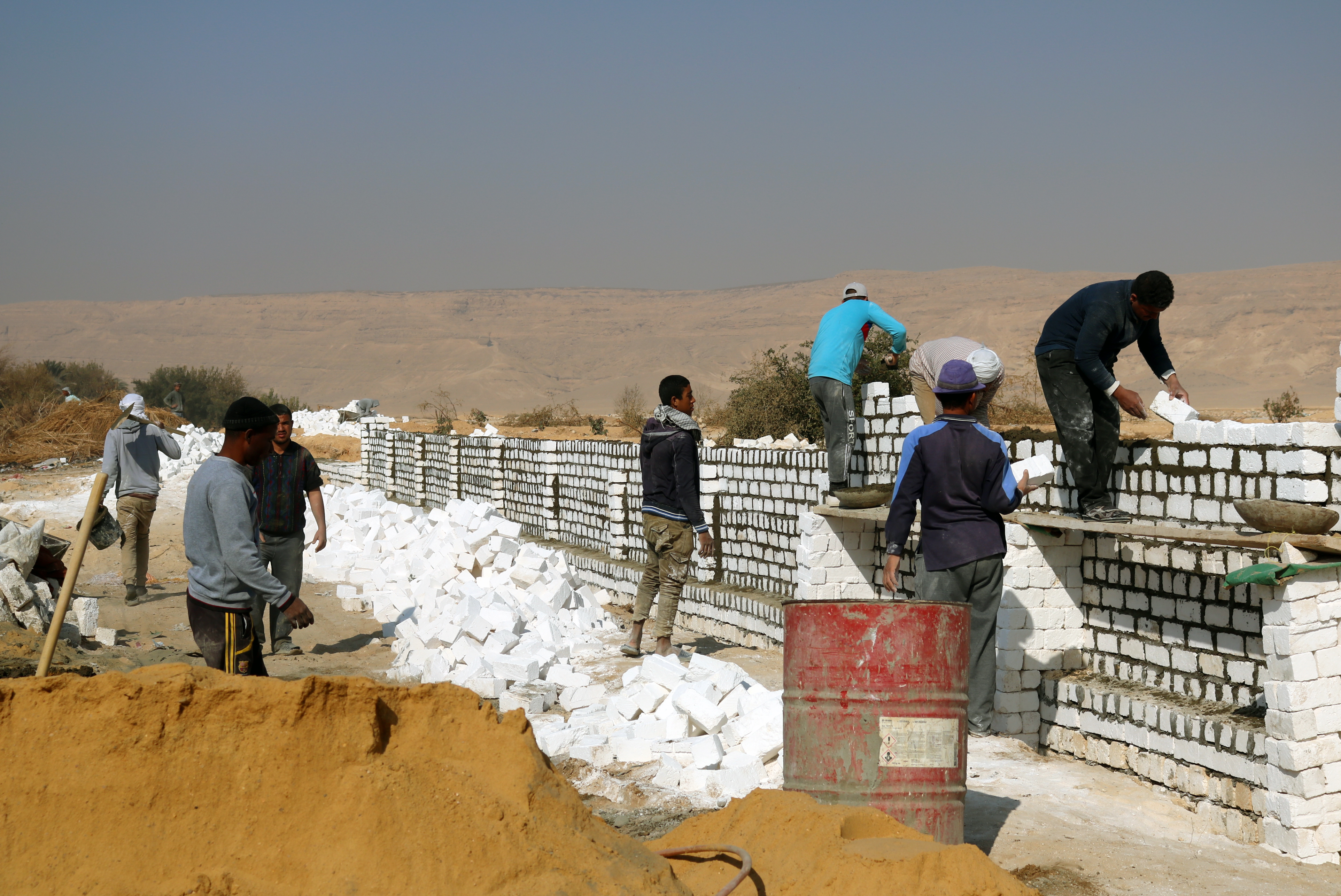- Era18th Dynasty
- Project DirectorAnna Stevens
- LocationAmarna Desert
- AffiliationUniversity of Cambridge|Monash University
- Project SponsorAntiquities Endowment Fund
- Project Dates2020-2021
Like many archaeological sites in regional Egypt, parts of Amarna, the 18th Dynasty city of King Akhenaten, are threatened by illegal agriculture. Recently, the Amarna Project (University of Cambridge), together with the Egyptian Ministry of Tourism and Antiquities (MoTA), started a program of protective walling to create buffer zones for threatened areas of the site, with the generous support of an AEF grant.
Mr Alaa Abdel Rahman (Directorate of Survey) sets the line of the wall, prior to construction. Photo: Amarna Project.
Our target area was a parcel of agricultural land north of the town of El-Till Beni Amran near the north end of the Amarna bay. In recent years, the privately owned fields here had started to extend eastwards onto Antiquities Land, coming to within around 50m of the ancient ‘Desert Altars’. This distinctive religious complex is visible in the distance on the road out to the North Tombs. It is formed of three huge mud-brick altars, each of a different design, surrounded by a simple stone enclosure. It is a very fragile site, which sits exposed on the desert floor. The site would be easily destroyed by encroaching field systems, with rising ground water also posing a threat. The Desert Altars are one of only two peripheral temples that now survive at Amarna, the other one being the Sun Temple of Nefertiti at Kom el-Nana. Originally, there were probably five or six such temples on the desert perimeter of the city. The function of the Desert Altars is not entirely clear, but they may have served the funerary cults of the important officials buried at the North Tombs nearby. The field systems were also beginning to extend northwards, into the North City, one of the residential areas of ancient Akhetaten, which also includes a large palace and administrative buildings.
Given the vulnerability of these areas, it was decided to build two lengths of stone wall along the north and east edges of the fields. This is the first time that a program of walling has been trialed at Amarna as a heritage protection measure. The work had the goals, most immediately, of helping to protect the Desert Altars and the North City. It also sought to create a buffer between modern settlement and the landscape of the North Tombs, which includes large Amarna Period pit-grave cemeteries, and to provide greater clarity regarding boundaries going forward.
Builders from El-Till Beni Amran and Deir el-Bersha construct the wall in December 2020. Photo: Amarna Project.
Work began in December 2020, launching with a survey and followed by construction of a 782m stretch of wall along the eastern edge of the fields. A second phase of work saw a shorter wall of 180m built to the north, adjacent to the ancient North City. The walls were built in limestone blocks to a height of 2m. The project was successfully completed in March 2021. The construction of the walls has helped to ease a point of tension for heritage managers at the site. The impacts of the walls on the site and local communities will continue to be monitored, and opportunities to extend the program to other parts of Amarna will be explored.
The partially completed wall near the Desert Altars, its foundations still to be backfilled, creating a local access road along the edge of the fields. Photo: Amarna Project.
Credits:
Team members:
Thank you to ARCE for supporting this work. The project was undertaken with the permission of the Ministry of Tourism and Antiquities (MoTA) and the support of the Mallawi MoTA office. Particular thanks are due to: Mr. Gamal Abu Bakr (Director of Middle Egypt Antiquities), Mr. Fathy Awad (Director, Southern Minia Antiquities), Mr. Hamada Kellawy (Chief Inspector, Mallawi Antiquities), Eng. Tarek El Sanadiki (Director of Projects Sector, Middle Egypt), Mr. Mahmoud Mohammed Mohsen (Inspector) and Mr. Salah Abdel Badea and Mr. Ahmed Abdullah (Survey Department, Mallawi).


